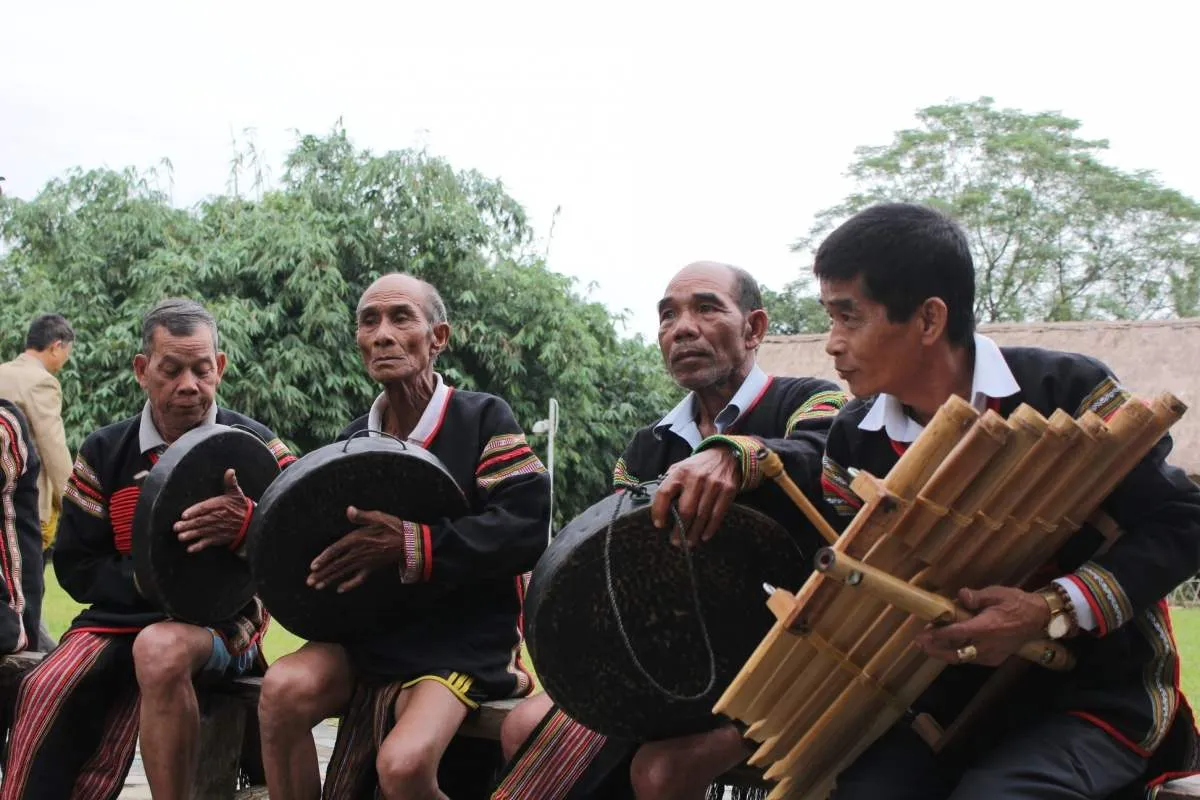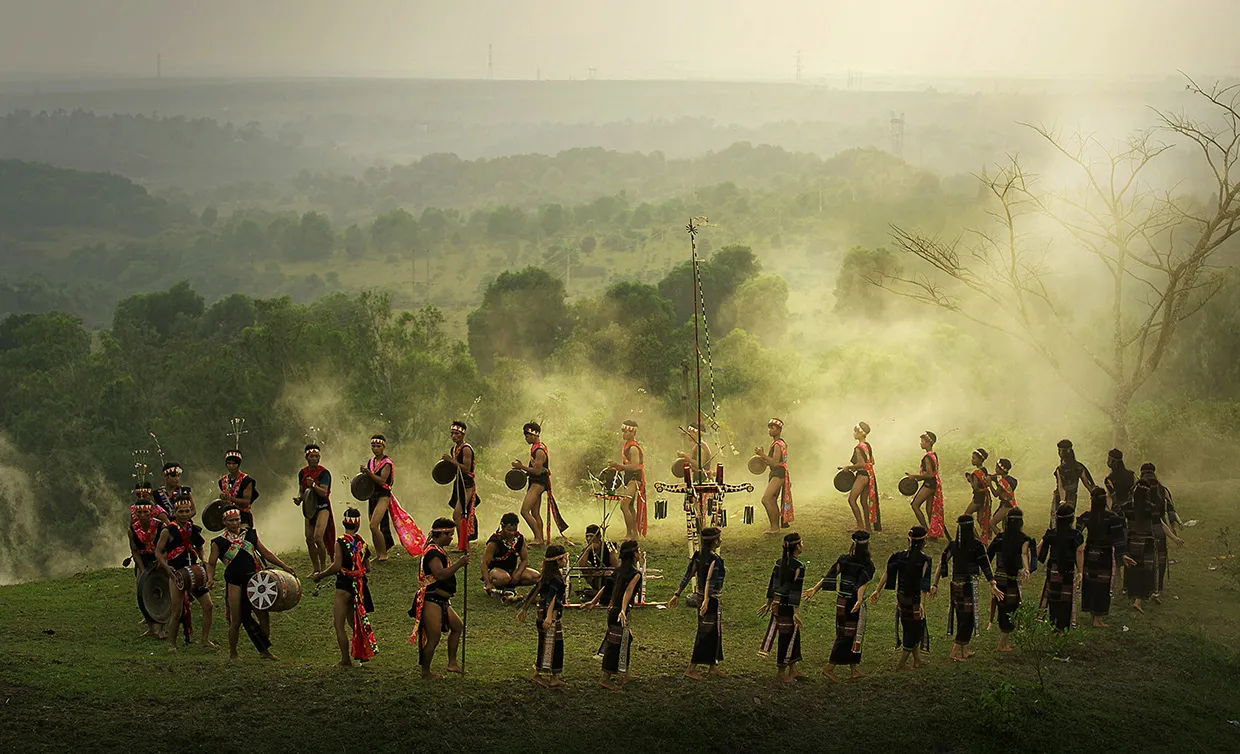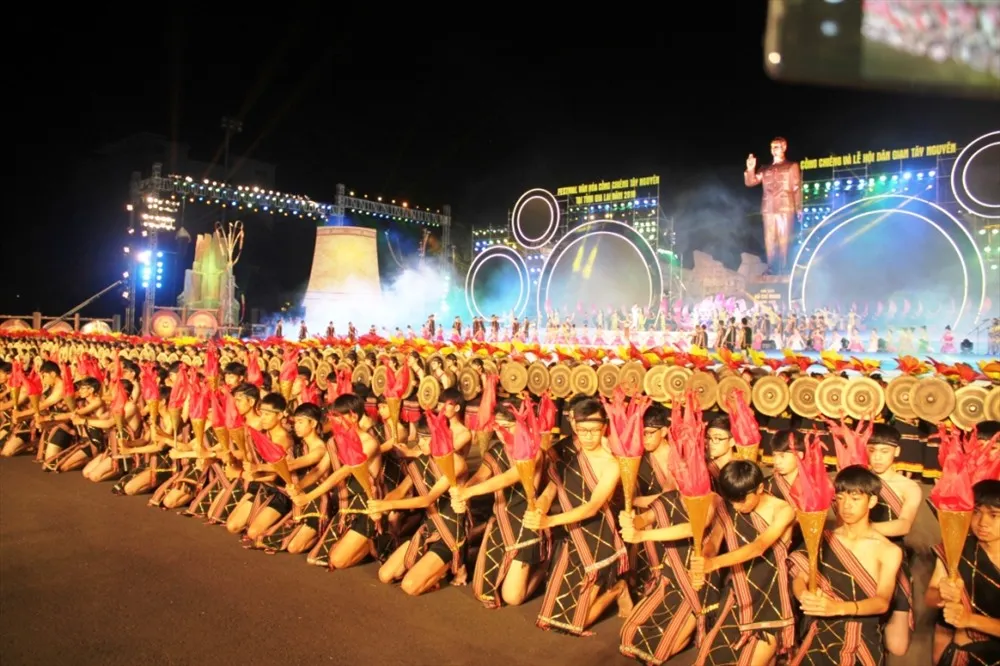The Gong Festival of the Central Highlands, a UNESCO-recognized intangible cultural heritage, is not just a mere cultural event but a vivid testament to the history, beliefs, and unique identity of the ethnic communities in the region. The sound of gongs resonating through the vast forest is not only music but also a spiritual language—a bridge connecting humans to deities, the past to the present, and generations to one another. Exploring the Gong Festival means discovering a rich cultural treasure and experiencing a deeply meaningful journey.
Gongs: The Language of the Mountains and Forests
Gongs, known as gong in English, are more than just musical instruments—they are iconic symbols of the Central Highlands culture. Their origins are believed to trace back to the Bronze Age, evolving from primitive stone and lithophone gongs. Over the centuries, gongs have been refined into intricate creations, adorned with unique carvings and motifs that reflect the life, beliefs, and aesthetic sensibilities of each ethnic group. Every gong is not just an instrument but a piece of art and a historical treasure preserved through its craftsmanship.

Since ancient times, the sound of gongs has echoed throughout the Central Highlands, inseparable from community activities, ranging from festivals to daily life. Their deep, resonant tones not only create a lively festival atmosphere but also serve as a medium for communicating with deities—the voice of the human spirit. Over time, the decorative patterns on gongs have evolved, mirroring the cultural development and historical imprints of their communities.
The Gong Festival: A Distinctive Cultural Event
The Gong Festival is not confined to one location but rotates annually across provinces in the Central Highlands, including Kon Tum, Gia Lai, Dak Lak, Dak Nong, and Lam Dong. Each province and ethnicity has its own distinctive ways of organizing the festival, contributing to the diversity and richness of Central Highlands culture.

The festival is not only an occasion for communities to demonstrate their solidarity but also an opportunity to promote gong culture to visitors from near and far. Tourists can immerse themselves in the vibrant festival atmosphere, marvel at spectacular gong performances, and learn about the culture and customs of the indigenous ethnic groups. The festival often intertwines with traditional rituals, creating a comprehensive and captivating cultural experience.
Gong Playing Techniques: A Blend of Skill and Artistry
Gongs can be played using two main techniques: with mallets or bare hands. Each technique produces distinct sounds, reflecting diverse emotional nuances. Soft mallets create warm, resonant tones, while hard mallets produce strong, vigorous sounds. Hand-playing techniques result in low, melancholic, and mysterious tones.

To deliver a complete performance, artisans must possess refined technical skills and synchronize seamlessly with their fellow musicians. Beyond mere technique, gong playing demands a profound understanding of music and traditional culture. Each gong rhythm carries its own meaning, closely tied to ceremonies and events within the community.
Gong Music: The Voice of the Soul
Gong music of the Central Highlands is highly diverse, featuring numerous pieces connected to various ceremonies and occasions throughout the year. Pieces like “Cheng,” “Spo,” and “Pru” played during buffalo sacrifice ceremonies embody boldness and valor, while “Arap,” performed at funerary rites, carries somber and poignant undertones, bidding farewell to departed souls.

Gong sounds transcend music—they are a medium of communication with deities and a voice of the human soul. Through their melodious, resonant notes, one can sense the emotions and aspirations of Central Highlands communities, their close bonds with nature, and their connections to each other.
Gong Festival in Lam Dong: Exploring Culture Amidst Mountainous Landscapes
In Lam Dong, particularly in Da Lat, the Central Highlands Gong Festival is often held to promote traditional culture to visitors. Tourists can experience unique rituals, witness captivating gong performances, and immerse themselves in the lively atmosphere.

Beyond enjoying the artistry of gongs, visitors also have the chance to learn about the culture and customs of local communities and gain insight into their lives closely intertwined with the forests. This is a remarkable opportunity to discover the unique cultural beauty of the Central Highlands, to understand the history, beliefs, and identity of its ethnic groups.
Conclusion
The Central Highlands Gong Festival is a precious cultural heritage and a testament to the richness and diversity of Vietnamese culture. Preserving and promoting the values of the gong festival is not only the responsibility of the Central Highlands communities but also of society as a whole. Hosting gong festivals is also a way to boost tourism and attract visitors to the Central Highlands, contributing to the region’s socio-economic development. Visit and experience the magic of the Gong Festival to fully appreciate the beauty of Central Highlands culture.